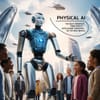Physical AI refers to artificial intelligence systems that can interact with and manipulate the physical world. This emerging field combines AI with robotics, computer vision, and sensor technologies to create intelligent machines that can perceive, reason, and act in the physical environment.
The development of physical AI has numerous applications across various industries, including manufacturing, healthcare, transportation, and logistics. Robots equipped with physical AI can perform complex tasks such as assembly, inspection, and maintenance, while autonomous vehicles can navigate through crowded streets and avoid obstacles.
As physical AI continues to evolve, it is expected to bring about significant improvements in robotics and automation, autonomous systems, and human-machine interaction. Physical AI-powered robots will become increasingly capable of performing complex tasks, leading to increased efficiency and productivity in industries such as manufacturing and logistics.
Autonomous vehicles and drones will also become more sophisticated, enabling them to navigate and interact with their environment in a more effective and safe manner. Moreover, physical AI will enable machines to better understand and respond to human needs, leading to more natural and intuitive interactions between humans and machines.
The potential impact of physical AI on society will be significant, transforming industries and revolutionizing the way we live and work. As physical AI continues to advance, it is essential to address the challenges and concerns associated with its development, such as ensuring safety, security, and accountability. With careful planning and development, physical AI can bring about tremendous benefits and improve the lives of people around the world.


